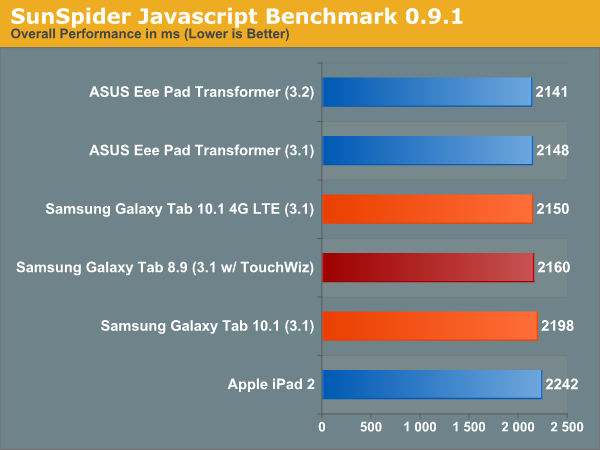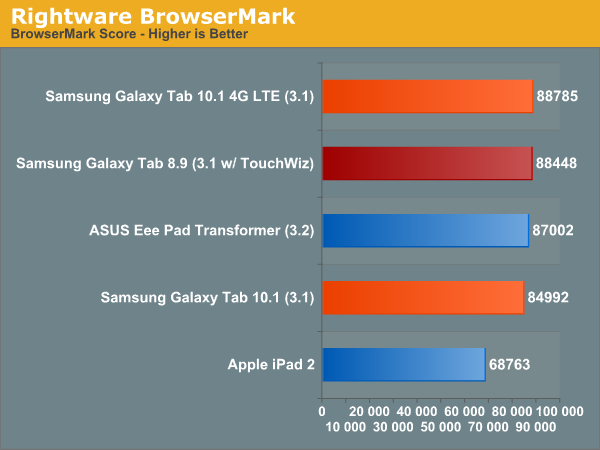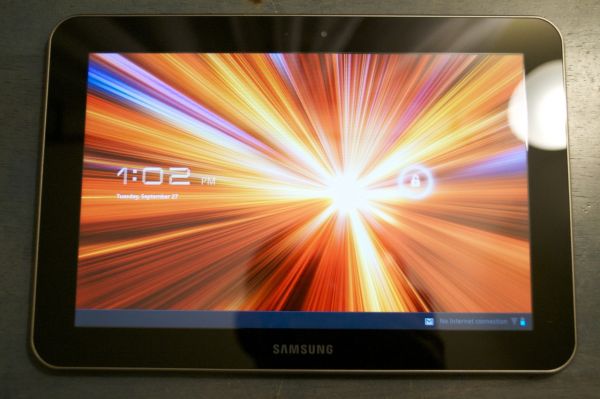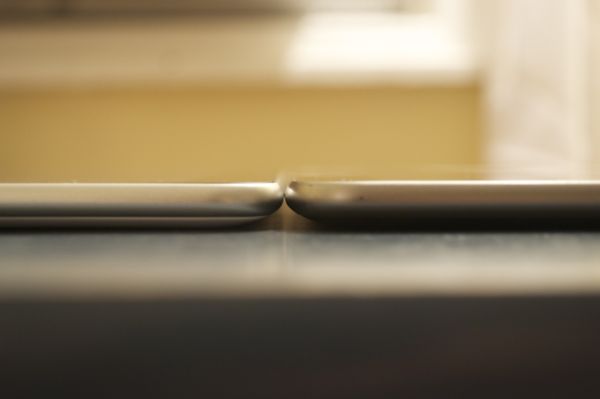Hands-on With The Galaxy Tab 8.9
by Jason Inofuentes on September 27, 2011 1:14 AM EST- Posted in
- Samsung
- News
- Galaxy Tab 8.9
- Android 3.1
- TouchWiz
- Laptops
- Galaxy Player
When we reviewed the Galaxy Tab 10.1 (a few times), we made clear that Samsung has spent a lot of time and effort to make these feel solid and well built. We also had kind words to say about the PLS display, and zippy performance from the Tegra 2 SoC and Samsung’s software optimizations. All of that still applies to the 8.9, but with the added benefit of a much more comfortable form factor. When in landscape, the 10.1 is narrow for Android tablets of that size, but that doesn’t make it any easier to thumb-type on without having to stretch for those G’s and H’s. Moving to 8.9 inches allows the user to hammer away without ever having to awkwardly change grip in order to get to the middle keys. In addition, this is one of the first Android tablets that feels comfortable to hold in portrait, with just one hand. The increased lightness and the ability to have less of the weight hang out beyond your grip makes this an easy device to use as a reader or media tablet.
Shrinking the size and maintaining the resolution brings pixel density up to 170 pixels per inch from 150 in the 10.1. Though this is barely more than a 10% increase, it is noticeable, and the superb PLS display Samsung uses produces vibrant colors and excellent viewing angles. With internals that match its larger brother, performance is equivalent, both in benchmarks and in user experience. TouchWiz UX is on hand, along with Android 3.1. Samsung expects to have Android 3.2 within the next few months, and it’s expected to launch on the 8.9 and 10.1 simultaneously. That should bring along some performance tweaks, as well as improved compatibility with varying screen sizes.
| Samsung 2011 Tablet Comparison | ||||||
| Samsung Galaxy Tab 8.9 | Samsung Galaxy Tab 10.1 | |||||
| SoC | NVIDIA Tegra 2 (Dual ARM Cortex A9 @ 1GHz) | NVIDIA Tegra 2 (Dual ARM Cortex A9 @ 1GHz) | ||||
| GPU | NVIDIA GeForce | NVIDIA GeForce | ||||
| RAM | 1GB | 1GB | ||||
| Display | 1280 x 800 PLS | 1280 x 800 PLS | ||||
| NAND | 16GB | 16GB | ||||
| Dimensions | 230.9 x 157.8 x 8.6mm | 256.6 x 172.9 x 8.6mm | ||||
| Weight | 447g | 565g | ||||
| Price | $469 |
$499 |
||||
Apple threw down the gauntlet when they made their already svelte iPad even thinner with the iPad 2. At 8.8 mm, it’s hard to believe that tablets can get much thinner. Samsung positioned the Tab family to get just a little bit thinner at 8.6 mm, a feat both the 8.9 and 10.1 accomplish. We put the 8.9 alongside some of its contemporaries in the gallery below, suffice it to say, no one does Android tablets as thin as Samsung. Is there value in thinness though? At times these paper thin devices feel awkward to grip, their flatness providing no edge to capture in your hand. In contrast the TouchPad’s curvy frame is easy to maintain a solid grip on, and even the Acer Iconia Tab’s chunkier metal frame feels easy to grasp. What makes it easy to overcome the thin frame is it’s lightness. At just under a pound this easily the lightest Android tablet I’ve held and the difference between it and even the 10.1 is the difference between something I would feel comfortable reading in bed with, and something I would fear dropping sleepily upon my head.
Galaxy Tab 10.1 (left) vs. Galaxy Tab 8.9 (right)
The Galaxy Tab 8.9 is a welcome addition to the swarm of Android tablets being introduced this Fall. Manufacturers now free to stray from the 10.1” form factor will finally be able to differentiate with more than just skins. In the case of Samsung’s latest, they took all the best traits from the best Android tablet available today, and shrunk it down to a more comfortable size. Does this make the 8.9 the new best? Stay tuned for Anand’s review.
Gallery: Galaxy Tab 8.9 Hands On





















33 Comments
View All Comments
seanleeforever - Tuesday, September 27, 2011 - link
way to go jtd871, we should totally saying random things without doing any research.it DOES have GPS, for both 5 and 4 inch, and i don't see any reason why 8.9 inch doesn't come with one. i know because i actually HAVE a 5.0 in my hand right now.
and if you went with woot deal last week, you would pay 169 dollar on a brand new 5.0, which is a lot cheaper than ipod touch.
name99 - Tuesday, September 27, 2011 - link
I don't want to be a prick here, but it seems a bit strange to have a review of a supposed iPod competitor which doesn't actually mention how well it performs this task.(a) Does it support Bluetooth? Because I didn't see a BT icon in the menu bar of any of the screen shots.
(b) How well does the music player SW work? Of course it offers the basics, but how well does it interface with desktops? If i LIKE iTunes, does it play well with that? Does it offer transcoding of songs (eg down to 128kbps AAC) in the transfer from desktop to device, so that I can fit more songs on the device? etc etc
(c) How well does it handle spoken word audio? Does it remember my place within a long spoken word file? Does it remember my place in a playlist (representing the files that make up a full book)? Does it allow me to play audio at faster than realtime --- and with what granularity of control over the speed? etc etc
(d) Likewise does it play VIDEO at faster than realtime --- this is important if one view a lot of podcasts and lectures which can be, let's say, leisurely paced.
(e) How well does the UI for random access within large files work? Does the device offer quick and easy ways to jump back a few seconds if you missed something, or forward a few seconds to skip over the boring intro to a talk?
Apple is not perfect in this space. The sad FACT, however, is that I've been following it for about 10 years now, and I still haven't found a company that can offer even the basics of what Apple offers, let alone a BETTER experience. Look, for example, at what I have listed in terms of better ways to handle spoken word audio/video --- Apple is pretty lame in that area. And yet everyone else (as far as I know) is even worse. It's like they are utterly incapable of original thought --- if Apple doesn't offer faster than real-time video, or multiple speeds for faster than real-time audio, they don't have that feature to copy and so don't offer it either.
joshera - Tuesday, September 27, 2011 - link
this is a hands-on, not a full review, this to have escaped a few people.seanleeforever - Tuesday, September 27, 2011 - link
a. yes it has bluetooth,b. music software is okay, it is a galaxy phone without the phone part, so you can download any software of your choice (but the built in one is better integrated to the phone software)
c. no idea what you talking about here... i personally do not know any music player that doesn't play word audio.. it is like saying whether a color screen can display black and white. again, there are downloadable software to do things that default software doesn't do.
d. the default video play may not support it, but there are application that do what you mentioned.
e. totally weird question. yes, like millions or other player, it does have a progress bar that you can use it jump back or forward.
HERE IS YOUR PROBLEM.... you didn't read the article did you? it is not ipod competitor, it is ipod TOUCH competitor. you apparently never used ipod touch or any thing quite like it. it has its own operation system that you can download application (sort like how windows doesn't do picture editing very well, but you can install Photoshop for that purpose) so pretty much all the questions you have are non-applicable.
time to use a smart phone bro.. technology has came a long way since ipod.
name99 - Tuesday, September 27, 2011 - link
Of course I'm familiar with an iPod Touch. Are you?(b) Does not answer the question. Software is "OK" does not help. Does it work with iTunes? Does it work WELL with iTunes? These are simple questions.
eg --- does it transfer playlists? Does it sync back with iTunes position and playcounts?
(c) The issue is not "playing" spoken word audio, it is that spoken word audio has DIFFERENT requirements than music. I freaking listed some of them:
- remember position (across reboots, resyncs, switching to other files, etc)
- don't include when in any sort of shuffle mode
- able to play at non-real-time speeds.
Apple does the first two well. It does the third OK, but with no choice of speeds.
I also mentioned remembering position in a playlist (ie the collection of files that make up an audiobook.) Apple does not do this at all.
(d) Really. You are SURE there are video player apps that do this well, or you are simply assuming it? Those apps use HW or they do the decode in SW (so they stutter and destroy battery life?)
(e) Have you ever actually tried to USE the progress bar to locate a position within a long file or movie? As opposed to seeing a still image and thinking "that looks cool". Because, let me tell you, it works like crap.
Apple tries, in iOS4, to do a better job with the variable speed sliding along the bar, depending on your vertical movement on the screen. But it's finicky and works badly if your finger sticks to the screen as mine tends to. It is USELESS for fine motions of the type I described.
Also in iOS4 Apple provides a button to jump backwards 30 seconds. This is conceptually a good idea but
- 30 seconds is usually way too longe. 10 sec would be better
- there is no forward equivalent.
As a general principle, when you see a post asking questions you don't understand , you can take one of two stances:
- the questioner is an idiot. I can read his mind, and clearly he is a fool OR
- perhaps this questioner has deep and subtle needs because he understands this tool rather better than I do.
You might want to consider in future which of these stances you should adopt.
And yeah --- I worked at Apple for ten years in the QuickTime group. I think I know what I'm talking about.
nealibob - Tuesday, September 27, 2011 - link
Your statement that "the 5.0 merits a $40 premium for its extra inch of screen real estate" is incorrect. The glass is larger, but you're not getting more. Looking at your home through a magnifying glass just makes it look larger, it doesn't add windows and bedrooms.800x480 at 4" is a joke. At 5" it's absolutely absurd. Anyone who buys the 5" over the 4" for nearly any purpose is a fool.
seanleeforever - Tuesday, September 27, 2011 - link
so a 32 in 1080p TV should not cost more than a 72 in 1080p TV since you are not getting more?what's next, a 3 thousand sq ft 3/2 house should cost the same as a 2 thousand sq ft 3/2 house because they all have 3 bed room and 2 bathroom?
you are getting MORE, more physical screen real estate. and 800x480 at 5" is not a joke. it is certainly nothing to write home about, but it does get the job done very well. again, use it before bashing it.
what you pay for 5 inch is larger battery and larger screen. it is easily the better of the two if you already have a 3.5 or 4 inch phone.
FlyBri - Wednesday, September 28, 2011 - link
I wouldn't necessarily just flat out say the 5" is EASILY better of the two. Yes, it's a bigger screen, and has a bigger battery (to me the larger battery in the 5" compared to the 4" is way more important than the larger screen), but just as Jason said in the hands-on preview, because the 5" uses a TFT-LCD and the 4" uses an S-LCD, which is a much better screen.So for people who care put a high priority on screen quality and want much better viewing angles and contrast, then in that sense, the 4" is clearly better, whether they have a 3.5" or 4" phone already or not.
The big thing for me is price. I'm sorry, but you're competing against the company which has the EXTREME majority of market share in this sector. Even if your product is better and has more features, you have to undercut them on your initial product entry, even if you take a loss, in order to gain enough interest to eventually take away decent market share from Apple. Microsoft arguably built a better music player in the most recent gen Zune compared to Apple's products, but it still failed. All these other companies competing with Apple don't get it when it comes to tablets, laptops, etc, and it looks like they're not getting it when it comes to music players either.
I was in the market for an ultra thin 13" laptop. I'm a PC guy -- always have been. But I ended up getting a MacBook Air to run Windows 7 on instead of a Samsung Series 9 because it offered a higher res screen, was of similar quality, and was cheaper. The Series 9 should have been $150 less than the MacBook air at MINIMUM, yet it's not even at the same price as the AIR...it's MORE expensive. They seriously have a lot to learn...
Mugur - Wednesday, September 28, 2011 - link
I agree, the price should be lower in order to gain market share. But for some people a lower price will mean lower quality, unfortunately... And, at least with Samsung this is not the case.Anyway, in my country Galaxy S2 has a much lower price (the unsubsidized price is like 70%) than an iPhone 4 and Tab 10.1 was about 50 EUR less than a similar equiped iPad 2 last time I've checked.
marvdmartian - Wednesday, September 28, 2011 - link
Hey tablet manufacturers, how about looking at making a 12" tablet? More real estate is always a plus, and it will be a hit with the older generation, whose eyes can't really work as well any more, and find it difficult to read anything on a smaller screen.Netbooks started out at 7", and now are primarily 10" screens, with some going as big as 12". So why haven't they followed suit with tablets??